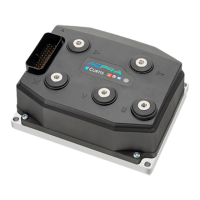4 — PROGRAMMABLE PARAMETERS
Curtis AC F2-A, F4-A, F6-A Motor Controllers – FOS 4.5 – April 2022 Return to TOC
pg. 38
Forward Forward movement is a positive (value) traction speed. On a Class III
truck with a tiller, “forks trailing” is the forward movement. For a reach
truck or counterbalanced truck, “forks leading” is forward movement.
Reverse Reverse movement is a negative (value) traction speed. On a Class III
truck with a tiller, “forks leading” is reverse movement. For a reach truck
or a counterbalanced truck, “forks trailing” is reverse movement.
PDO PDOs (Process Data Objects) pack up to 8 bytes of data into
highly efficient messages that are used to transfer run-time data
between devices while in the Operational Mode. PDOs can be
sent (TPDO) or received (RPDO) by any device. Most devices rely
on PDOs for operational data transfer, but it is not mandatory.
PDOs use the Producer-Consumer protocol. There can only be one
Producer (transmitter) of a specific PDO COB-ID, but many (or no)
Consumers (receivers).
e PDO mapping structure uses the object index to dene the data
within any given PDO. See PDO Setup, Appendix A.
Curtis uses the Manager for RPDO and the Ancillary for the TPDO.
RPDO Receive Process Data Object (RPDO). Data received by the Consumer
from Producer communication (e.g., the ancillary controller receives
data from the manager controller).
RX Receive. In CANopen, RX (Rx) is from the perspective of the
ancillary controller.
TPDO Transmit Process Data Object (TPDO). Data transmission by the PDO
Producer to PDO Consumer (e.g., the ancillary controller(s) transmits
data to the manager controller).
SDO Service Data Object (SDO). A SDO is a low priority message used to
transfer multiple data sets from a client to a server and vice versa.
Several types of data transfer are available, with the Client (manager
controller) taking the initiative for a transfer. Use the SDO process to
read or write to an object index of a Server (ancillary controller). A SDO
is used for conguring the controller via the CAN network. Dened
within the Object Dictionary are the contents of the data set. See
Appendix A for an example SDO to congure the PDO map.
SDO Download rough this service, the client (e.g., manager) of a SDO downloads data
to the server (e.g. the owner of the Object Dictionary). A “write” operation.
SDO Upload rough this service, the client of an SDO uploads (reads) data from
the server (owner of the Object Dictionary). A “read” operation.
TX Transmit. In CANopen, TX (Tx) is from the perspective of the
ancillary controller.
VCL VCL is the unique Curtis Vehicle Control language. VCL provides
the application level programmability to customize the usage, or
allow Curtis AC motor controllers to perform as ‘vehicle managers’,
eliminating the need for additional system controllers.
See the Curtis website: Curtis Vehicle Control Language (VCL).

